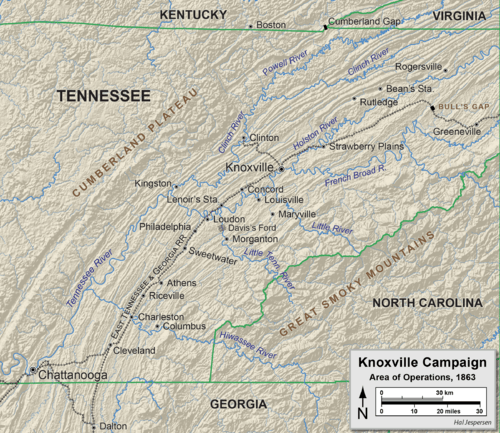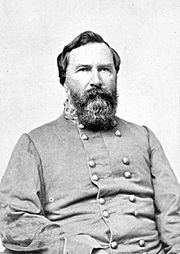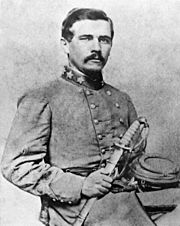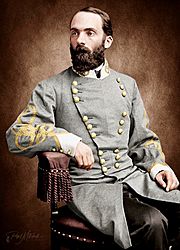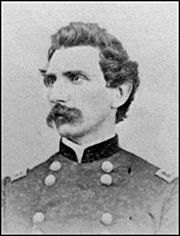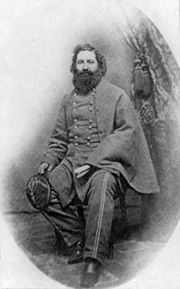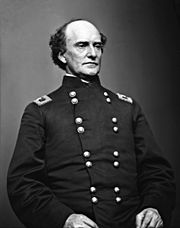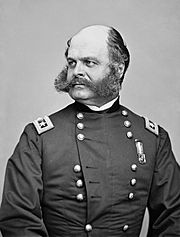Battle of Campbell's Station facts for kids
Quick facts for kids Battle of Campbell's Station |
|||||||
|---|---|---|---|---|---|---|---|
| Part of the American Civil War | |||||||
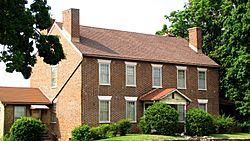 The Avery Russell House, built in 1835, stands on the Campbell's Station battlefield. |
|||||||
|
|||||||
| Belligerents | |||||||
| Commanders and leaders | |||||||
| Ambrose Burnside | James Longstreet | ||||||
| Units involved | |||||||
| Army of the Ohio | Confederate Forces in East Tennessee | ||||||
| Strength | |||||||
| 9,000 | 12,000 | ||||||
| Casualties and losses | |||||||
| 400–438 | 570 | ||||||
The Battle of Campbell's Station happened on November 16, 1863, during the American Civil War. It was fought near what is now Farragut, Tennessee. In this battle, Confederate forces led by General James Longstreet attacked Union troops under General Ambrose Burnside.
Longstreet wanted to defeat Burnside's Union army before they could reach the city of Knoxville. The Confederates pushed the Union soldiers back from several positions. However, Burnside's troops managed a successful "fighting withdrawal." This means they fought while slowly moving back, which helped them escape safely.
Because Burnside's army wasn't trapped at Campbell's Station, Longstreet had to lay siege to Knoxville. This siege failed when more Union forces arrived to help Burnside. Longstreet was then forced to retreat.
Contents
Why the Battle Happened
Union Troops Arrive in East Tennessee
In August 1863, Union General Burnside led his army into East Tennessee. His goal was to take control of the area. Most people in East Tennessee supported the Union, so they welcomed the soldiers. By September 1, Union troops had taken over Knoxville.
However, the situation changed when Confederate General Braxton Bragg defeated another Union army at the Battle of Chickamauga. After this victory, Bragg's army surrounded the Union forces in Chattanooga.
Longstreet's Plan to Take Knoxville
On November 4, General Bragg ordered General Longstreet to leave his main army and try to capture Knoxville. Longstreet had about 10,000 infantry soldiers, 5,000 cavalry, and 35 cannons. He wanted to surprise Burnside's army and stop them from reaching Knoxville's defenses.
Longstreet planned to cross the Tennessee River at Hough's Ferry. One part of his army would cross first, while another part marched to distract the Union soldiers. Meanwhile, Confederate cavalry under General Joseph Wheeler would try to attack Knoxville from the south.
The March to Campbell's Station
Crossing the River
On November 13, Confederate soldiers crossed the Tennessee River at Hough's Ferry. They quickly built a bridge. Union troops tried to stop them but couldn't.
On November 14, Longstreet's first division crossed the river. General Burnside ordered some of his troops to check on the Confederates. These Union soldiers fought a small skirmish, losing 47 men.
Retreat from Lenoir's Station
On November 15, Longstreet's attack began. Union forces, including those led by General Edward Ferrero, retreated towards Lenoir's Station. The roads were very muddy because of heavy rain, which slowed everyone down.
That evening, Burnside decided to move his entire army towards Knoxville. He sent his artillery and supplies ahead. The Union soldiers destroyed anything they couldn't carry. A small group of Union soldiers, called the rearguard, stayed behind to protect the retreat.
Confederate troops, especially those led by General Micah Jenkins, followed closely. Longstreet hoped to cut off Burnside's retreat, but it was dark, and he didn't have good maps. The night was also very cold, making it hard for soldiers on both sides.
Wheeler's Cavalry Attack
While Longstreet chased Burnside, General Wheeler's Confederate cavalry tried to attack Knoxville from the south. On November 13, Wheeler's horsemen crossed the Little Tennessee River. They tried to trap Union cavalry near Maryville, but most of the Union soldiers escaped.
Wheeler's cavalry continued to push the Union cavalry back towards Knoxville. By the evening of November 15, they had driven the Union horsemen right up to the city's defenses. However, Union infantry stopped them. On November 16, Longstreet asked Wheeler to join him, but it was too late for Wheeler to help cut off Burnside's retreat.
The Battle at Campbell's Station
Morning Fights
Burnside's army marched all night to reach Campbell's Station. The roads were so muddy that mules had to help pull the cannons. A Union rearguard, led by Colonel William Humphrey, protected the retreating army.
Campbell's Station was an important crossroads. Union General John Hartranft set up his soldiers to defend this spot. Confederate troops, led by General Jenkins, attacked the Union rearguard. Humphrey's small brigade fought bravely, making several stands to slow down the Confederates.
The Union soldiers fought from different positions, slowly falling back. They held a fence line, then a hill, and then another position near a creek. Each time, they fought hard before retreating in an organized way. This allowed Burnside's wagon trains to pass safely towards Knoxville.
Afternoon Attacks
The fourth Union stand was on the east side of Turkey Creek. Burnside chose this spot because it was high ground and open. Union artillery was placed to fire on the approaching Confederates. More Union troops arrived and took their positions.
Around noon, General Jenkins' Confederate division attacked. Soon after, General Lafayette McLaws' Confederate division arrived. Longstreet had about 12,000 men, but only Jenkins' division was fighting at first.
For three hours, there wasn't a major attack. Instead, it was mostly an artillery duel, where cannons fired at each other. Both sides had cannons damaged. Around 3 PM, Jenkins tried a flanking attack, moving his brigades to try and get around the Union left side. However, this attack didn't go as planned.
By 3 PM, Burnside was ready to pull back again. His troops managed another organized retreat. Neither Jenkins nor McLaws made a strong effort to stop them.
At 4 PM, Union soldiers made their fifth and final stand on high ground near the Kingston Road. Confederate infantry tried to advance but were stopped by Union artillery fire. Another artillery duel started. By 6 PM, Burnside ordered his men to retreat one last time. The first Union soldiers reached Knoxville at 4 AM on November 17, after a very long and tiring march.
Results of the Battle
Union officers were proud of how their units fought and moved during the battle. Artillery played a big role for both sides.
The battle resulted in about 400 to 438 Union casualties (killed, wounded, or missing) and about 570 Confederate casualties. The Union lost 31 killed, 211 wounded, and 76 missing at Campbell's Station.
The fighting at Campbell's Station and Lenoir's Station was Longstreet's best chance to defeat Burnside's army in the open. His failure to do so meant he had to besiege Knoxville, which was much harder. Longstreet later blamed his guides and lack of maps for not being able to outmarch Burnside. However, he had been told about the opportunity but didn't act quickly enough.
Burnside, on the other hand, managed his smaller force very well. He kept his army ahead of the Confederate chase. This not only saved Knoxville from being captured but also pulled Longstreet's forces further away from General Bragg's army, which was facing a large Union build-up. This helped the overall Union strategy.
On November 29, 1863, Longstreet learned that General Ulysses S. Grant had defeated Bragg's army at the Battle of Missionary Ridge. This meant Longstreet's supply lines were cut. With a large Union army coming to relieve Knoxville, Longstreet had to end the siege on December 4 and retreat.
Preservation
Campbell's Station became the town of Farragut, Tennessee in 1980. The town was named after Admiral David Farragut, who was born nearby.
The Avery Russell House, also known as the Campbell's Station Inn, was built in the early 1800s. It was a popular stopping place for travelers. Famous visitors included Tennessee Governor John Sevier and President Andrew Jackson. The house is still standing today at the corner of Kingston Pike and Campbell's Station Road. There is also a historical marker at Farragut Town Hall that remembers the Battle of Campbell's Station.
Images for kids


